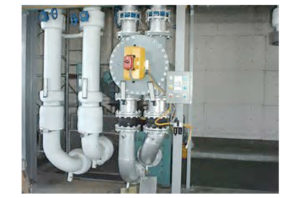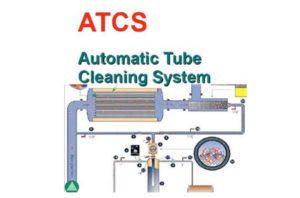Off-line cleaning methods require periodic shutdown of the process for heat exchanger cleaning via hydro blasting, scrapers, nylon or metallic brushes or chemical cleaning. Automatic tube-cleaning systems can be the answer…
Chillers are the largest consumers of power at commercial, residential and industrial facilities, worldwide. Be it a hotel, mall, hospital, university, school, airport, office building or a factory, you name it… if it has a chiller, nine times out of 10, it is the largest consumer of power.
With a water-cooled condenser, such as a centrifugal chiller, and with the harsh and dusty conditions we face in the GCC region, reducing the fouling and the scaling, increasing the heat-transfer efficiency and reducing the kW/tonne consumption should be the primary consideration.
In HVAC applications, fouling of the chiller condenser tubes has a substantial impact on the power consumption of the centrifugal compressor. Even with good water treatment programmes, it’s common to find chillers that appear to be in good working order operating at a fouling factor of 0.0025 hr-ft2-F/Btu, or higher – causing the compressor power consumption to increase by 25% or more.
Fouling occurs, because cooling water contains minerals, such as calcium and magnesium that precipitate to form deposits on heat-transfer surfaces. Cooling water systems are also commonly plagued by biological growth that form slime (bio-film) or algae on heat-transfer areas. Additional foulants include mud, silt, sand, corrosion products and petroleum products. These foulants reduce the heat-transfer efficiency of even the best-designed heat exchangers; induce localised corrosion, leading to early equipment failure; and force shut-downs of the chiller.
Several methodologies are commonly used to mitigate or reduce fouling in chilled water plants. Typically, these include off-line mechanical or chemical cleaning or on-line mechanical cleaning systems.
Off-line cleaning methods require periodic shutdown of the process for heat exchanger cleaning via hydro blasting, scrapers, nylon or metallic brushes or chemical cleaning. Automatic tube-cleaning systems can be the answer, leading to significant savings for chilled water plants.
Automatic tube-cleaning systems can solve condenser fouling and scaling problems that can cost you thousands upon thousands of dollars in unnecessary energy costs. The fact is that annual – which is most often the case – or periodic manual cleaning of a chiller’s condenser requires the chiller be shut down and taken out of beneficial service. However, after the exchanger is cleaned and returned to beneficial service, the fouling and scaling starts to develop almost immediately, lowering the efficiency of the condensers and chillers and increasing the chiller’s kW/tonne consumption until the next condenser cleaning, again, generally, 12 months later.
I will now discuss two types of automatic tube-cleaning systems…


BRUSH SHUTTLE CLEANING SYSTEM
There are many types of these Brush Shuttle Cleaning systems available in the market by different manufactures. The following is a generic explanation of the system, as they all basically operate and perform the same.
Each condenser tube is equipped with a brush and two catch baskets. The baskets are attached to each tube end by means of special epoxy. The baskets are designed to allow for easy removal and replacement of the brushes, when they wear out. The baskets are designed to hold the brush outside the tube and away from the condenser water path to avoid flow restriction and prevent measurable additional pressure drop across the heat exchanger.
The flow diverter or four-way diverting valve is housed within the condenser piping to and from the heat exchanger. It is “custom” designed for various piping configurations. The valve allows for periodic flow reversal through the heat exchanger at preset times, without reducing or stopping the flow through the condenser and without taking the chiller out of service or interrupting its operation.
The valve’s operation is initiated by the programmable control panel, based on the cleaning frequency it is set up for. Once it is initiated, the valve changes the flow direction through the condenser, shuttling the brushes out of their basket position into the tube, until they are captured by the basket at the opposite end of the tube. The valve keeps the flow in the reverse direction for a few minutes, until it is returned to its normal operating position, returning the flow inside the tubes to their original normal flow direction. Once the normal flow cycle is established, the brushes return to their start position, while brushing the tube again. The brush has a small interference fit within the tube, gently brushing away any foulant and scale that is built inside the tube between each cycle of operation. The cycle of operation is repeated as many times as necessary, based on the conditions and the severity of fouling and scaling. Repeating the on-line cleaning cycle many times each day will prevent debris, sand sediment and scale to build up in the inner surface of the tube, and will keep the condenser efficiency at its design condition, increasing the condenser’s real world performance.
BALL AUTO CLEANING SYSTEM
Sponge ball-type automatic tube-cleaning systems were originally conceived by German engineers in the 1950s for application in the power generation industry. Since they are effective at maintaining the heat-transfer efficiency of large-scale condensers, and applicable to once-through cooling systems that may have limited or no chemical treatment, they have been widely adopted in the power generation industry around the world. Globally, more than 15,000 sponge ball-type tube-cleaning units have been placed in service in the power generation sector alone, with 50% of total generating capacity in Europe and 40% of generating capacity in Japan. For liquid chillers, the operation of sponge ball-type automatic tube-cleaning systems is based on the passage of elastomeric balls through the condenser tubes. The balls are slightly larger than the tube diameter and prevent the deposition of scale and fouling materials. The sponge balls are periodically injected into the cooling water inlet line and are circulated through the condenser tubes by the cooling water flow. The balls are designed and injected in a method that enables a uniform distribution of balls across the tube sheet. Since the diameter of a ball is slightly larger than the inner diameter of the tube, accumulation of deposits in the condenser tube is prevented by shear forces between the ball and tube wall and the wiping action of the cleaning balls. The balls are constructed of material that is much softer than the tubes, preventing tube erosion.
The balls are collected at the outlet of the condenser in a ball trap, which includes a strainer or screen that allows water flow to continue but prevents the balls from escaping downstream. These ball trap designs utilise perforated screens of unique geometry that require no moving parts and can ensure that no balls escape to downstream processes. After the balls are accumulated in the ball trap, they are returned to a ball collector through the operation of a recirculation pump, which supplies the necessary pressure differential for conveying the balls. The collector serves as a holding vessel between ball injections and also as a method for replacing balls in the system. The entire injection and collection process is fully automated and controlled by means of a single programmable logic controller. The controller also provides monitoring and alarm functions to ensure the system is continuously operating optimally.
Again, the sponge ball-type tube-cleaning system technology has been a widely adopted best practice for optimising condenser performance in the power generation industry for decades. Advances in tube-cleaning system technology have resulted in more effective and reliable systems with enhanced scalability for the liquid chiller industry.
Automatic Tube Cleaning systems (Ball or Brush) deliver

From experience, I believe that one type of cleaning system is far superior to the other, but I do not want to publicly endorse one over the other. If any reader would like my opinion on this, I can be contacted directly at my email address.
_________________________________________________________________________
Dan Mizesko is Managing Partner, U.S. Chiller Services Int, HVAC & Energy Services International. He can be contacted at dan@uschillerservices.com.
CPI Industry accepts no liability for the views or opinions expressed in this column, or for the consequences of any actions taken on the basis of the information provided here.
Copyright © 2006-2025 - CPI Industry. All rights reserved.